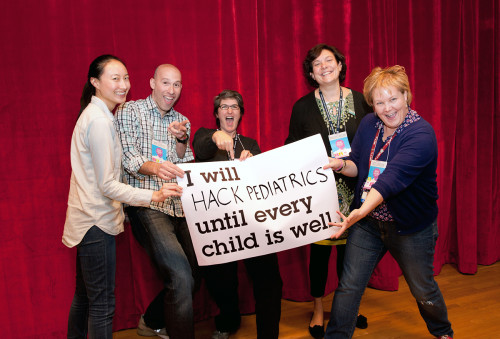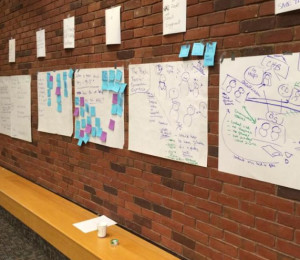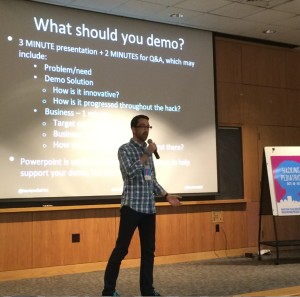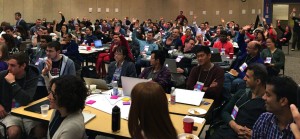 Michael Docktor, MD, is a pediatric gastroenterologist, director of clinical mobile solutions at Boston Children’s Hospital and a co-founder of Hacking Pediatrics. Above: The Hacking Pediatrics executive team: Judy Wang, MS; Michael Docktor, MD; Alex Pelletier, MBA; Margaret McCabe, PhD, RN, PNP; Kate Donovan, PhDc, MBA, BS, from Boston Children’s Hospital. (Photos: K.C. Cohen)
Michael Docktor, MD, is a pediatric gastroenterologist, director of clinical mobile solutions at Boston Children’s Hospital and a co-founder of Hacking Pediatrics. Above: The Hacking Pediatrics executive team: Judy Wang, MS; Michael Docktor, MD; Alex Pelletier, MBA; Margaret McCabe, PhD, RN, PNP; Kate Donovan, PhDc, MBA, BS, from Boston Children’s Hospital. (Photos: K.C. Cohen)
A hackathon is most easily explained by relating it to the crowd-sourced, time-crunched challenges that we see every day in pop culture. From “Top Chef” to “The Apprentice” to “Extreme Makeover,” television is teeming with passionate individuals trying to solve a difficult task with incredibly constrained resources and time. What results is often remarkable by any standard and speaks to the power of concentrated, collaborative problem solving.
When the challenge involves children and their health, the results can be magical, as witnessed by the weekend-long Hacking Pediatrics in late October, the first event of its kind. More than 150 “hackers,” including engineers, designers, software developers, entrepreneurs and roughly 40 clinicians gathered to create ground-breaking solutions for children and their families.
At the end of this 36-hour marathon, produced in collaboration with MIT’s H@cking Medicine, 16 teams presented their work to the crowd and judges. Ultimately, seven cash prizes were awarded, along with Amazon Web Services credits and opportunities for mentorship from leadership at Boston Children’s Hospital, Chief Innovation Officer Naomi Fried, PhD, and the organizers of Hacking Pediatrics and H@cking Medicine. In the future, we hope to connect these nascent start-ups with Bolt, a Boston-based hardware incubator, and HealthBox, a prominent health care accelerator.
Designing solutions for children and their families has a unique set of challenges, risks and ultimate rewards. For one, pediatrics is unique in involving many parties including parents, grandparents and teachers—all of whom can play a critical role in the care ecosystem. Further, children, especially young children, often rely on the ability of others to interpret their needs—both an obstacle and an opportunity for technology to serve as a translator. Finally, the pediatric marketplace is among the most underserved niches, offering ripe opportunities for entrepreneurial endeavors.
Thinking different, going Lean—in medicine?
The very nature of how we traditionally build solutions in medicine and academia lies in distinct contrast to the incredibly successful Silicon Valley model. The difference is embedded in the culture and process.
In medicine and academia, an investigator identifies a problem, builds a team of like-minded experts and writes a grant application to obtain the resources to build it and study it—with the long-term chance of getting a solution into the marketplace. In contrast, a hackathon gathers a community of experts from a wide array of disciplines, most of whom have no prior experience with the problem, to “hack” at an idea as a group.
This diverse assemblage of people has the collective ability to “think different” and is more likely to generate unprecedented advances, as demonstrated by Apple and the “creative confidence” design gurus at IDEO. Turning the academic problem-solving model on its head even further, the crowd cooperatively and collaboratively develops the concept, rapidly prototypes it, tests it and iteratively improves upon it as it enters the market. This “Lean” methodology is a faster, more efficient way to get from an idea to a product and has permeated the mindset of technology and software start-ups alike.
This model’s attractiveness as compared to laborious NIH grants has led to a boon in medical entrepreneurship. The collective intelligence of a diverse group, as opposed to experts with a narrow skill set, often results in a commercially viable product whose design is based on a better understanding of end-users and the marketplace.
Measuring success
Although the term is overused, our inaugural hackathon event was disruptive for Boston Children’s and, we think, for the medical and technology communities in Boston, who are beginning to realize the opportunities for fruitful and powerful collaboration. Hacking Pediatrics was a grass-roots effort in which many career clinicians stepped out of their comfort zone and entrusted in an entirely new process. Many described it as terrifying, enlightening and transformative to think of themselves as “innovators.”
 But with any idea at a hackathon, the challenge is in the execution—continuing on the difficult journey to a viable product. Success from a hackathon must be measured in both soft and hard return on investment (ROI). The hard ROI is the traditional business measure of achievement. Do our graduates go off and start profitable businesses that improve the quality of a child’s life? In the early days of health care hackathons, this was a challenge, but success is happening with increasing frequency.
But with any idea at a hackathon, the challenge is in the execution—continuing on the difficult journey to a viable product. Success from a hackathon must be measured in both soft and hard return on investment (ROI). The hard ROI is the traditional business measure of achievement. Do our graduates go off and start profitable businesses that improve the quality of a child’s life? In the early days of health care hackathons, this was a challenge, but success is happening with increasing frequency.
The soft ROI, while more difficult to measure, may in fact be the more enduring and valuable metric. The hope here is that Hacking Pediatrics will serve as the tipping point for creative and collaborative innovation at Boston Children’s and elsewhere—bringing unprecedented talent and resources together and catalyzing opportunities to truly change the face of pediatrics.
So what’s next?
In planning Hacking Pediatrics, we were keenly aware of the propensity for great ideas to flounder and ultimately perish after hackathons. Ensuring the success of our graduates is of paramount importance in fostering future interest and the mindset that anyone at Boston Children’s can build something incredible. While the hackathon model is a fantastic one for a single event, an idea will remain just that unless the resources are in place to craft it, shepherd it and “fully-bake” a solution. Unfortunately, as the Brookings Institution recently pointed out, most academic establishments have yet to develop these resources.
To ensure the ongoing success of our motivated teams, we’ve developed a network of experts at Boston Children’s, MIT and the larger Boston-area community to serve as mentors and provide resources to incubate the new ideas. Ultimately, we hope to move the ideas forward, with guidance from the Innovation Acceleration Program’s FastTrack Innovation in Technology team, into a start-up accelerator such as HealthBox or directly out into the marketplace with help from our Technology and Innovation Development Office.
We will continue to grow our network of passionate solvers and “hackers” interested in helping children. Monthly meet-ups to continue the excitement and networking opportunities are already being planned, and Hacking Pediatrics 2.0 is in its formative stages. Stay tuned and check out our Hacking Pediatrics website, pictures from the hackathon and coverage on Vector and MedTechBoston.









